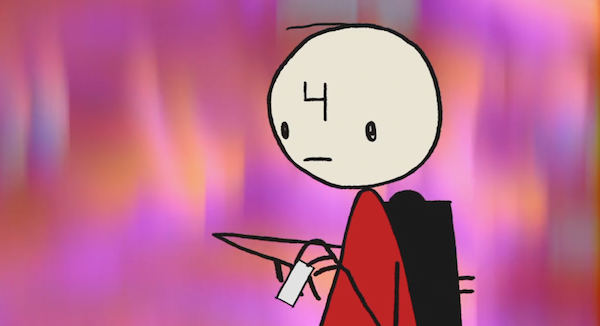Movie review by Greg Carlson
Animator Don Hertzfeldt holds at bay the crushing malaise of life during pandemic-time and reaffirms his status as one of the planet’s most accomplished filmmakers with “World of Tomorrow Episode Three: The Absent Destinations of David Prime.” The presumptive conclusion of his second major trilogy, the thirty-four minute adventure leaves admirers drooling like one of the title character’s imperfect clones. If Hertzfeldt’s ability to successfully expand on the emotional terrain and metaphysical considerations of previous chapters is a recipe, then he is an impeccable cinematic chef de cuisine.
Considering Hertzfeldt’s uncanny gift for sequels of increasing depth and breadth, nothing stands in the way of future “World of Tomorrow” installments. Fans may still clamor for an all-in-one feature-length Hertzfeldt effort yet to materialize, but there is much to appreciate in the artist’s longtime method — a kind of artistic accretion that functions like its astrophysical parallel, gravitationally pulling together particles into one massive whole. Like the preceding films in the “World of Tomorrow” series and the trio of “Everything Will Be OK,” “I Am So Proud of You,” and “It’s Such a Beautiful Day,” one can look at the pieces separately or together. Either way, the conclusion is the same: Don Hertzfeldt is a master of his form.
The special potency of the original “World of Tomorrow” in 2016 appealed to critics and audiences alike. Worries about Hertzfeldt’s move to digital animation were quickly quelled. The film received a Sundance Grand Jury Prize, Hertzfeldt’s second Academy Award nomination, and dozens of honors from the film festivals in which it was screened. Like the earlier stories featuring memory-challenged protagonist Bill, “World of Tomorrow” executed a dazzlingly choreographed fireworks display of colorful rockets alternating bursts and plumes of humor and horror. Hertzfeldt continued to etch his key themes, contemplating mortality, temporality, memory, love, and loss.
Winona Mae’s beloved Emily Prime is now absent, but happily, Hertzfeldt enlists Jack Parrett as young David, briefly returning to the technique of hilariously visualizing and integrating the captured-moment child’s-eye views and observations that mapped a large share of the inaugural passage’s dynamism: “We have a rabbit! And a shark! A universe!” In one of the movie’s many highlights, Hertzfeldt situates Parrett’s thoughts in an incongruously innocent kaiju nightmare. Assault helicopters fire on the evolving Godbaby while it knocks down towers and terrorizes a cityscape. The inspired lunacy is classic Hertzfeldt.
Julia Pott returns as Emily and deftly handles all the convoluted time travel explanations with her character’s established affinity for deadpan gallows humor: “Death was instantaneous. Probably.” In contrast, aside from some “uncontrollable horrifying screaming noises” that come from an adult iteration of David, the mature figure’s quietude aligns him with the determined and indefatigable silent era dreamers portrayed by Buster Keaton and Charlie Chaplin. The stakes are high and the sacrifices great. David must continually dismantle aspects of selfhood, deleting parts of his own neural operating system to carry out his quest.
Later, in what might be the film’s most stunning piece of purely visual storytelling, Hertzfeldt revisits a pivotal moment that we first saw from Emily’s point of view, taking us “between the frames” to experience a previously hidden series of events that expands the greater “World of Tomorrow” mythology and deepens our appreciation for the moviemaker’s skill. It would be terribly unfair to say much more about that sequence and risk spoiling it for those who have not yet viewed the film (what are you waiting for?), but it rearranges our previous perceptions with a “Rashomon”-like epiphany that suggests there is no ceiling for Mr. Hertzfeldt. I’m already counting the days until his next movie.
